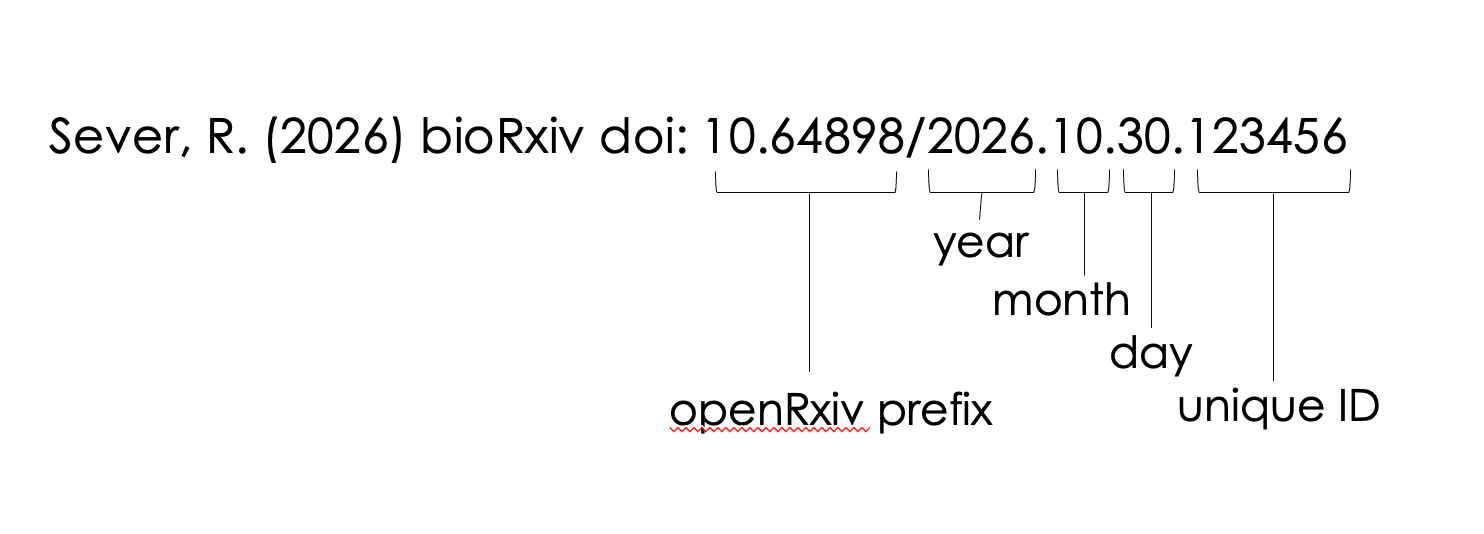News & Notes > Understanding DOIs for preprints: How openRxiv assigns and manages persistent identifiers
Understanding DOIs for preprints: How openRxiv assigns and manages persistent identifiers
bioRxiv | 2025-11-18
Digital object identifiers (DOIs) are a class of persistent identifier (PID) assigned to an object to ensure that it can always be uniquely identified and, ideally, accessed reliably. Each DOI is a unique alphanumeric string that is registered with a DOI registration agency, such as Crossref or DataCite, which maintains a record of the object and a variety of information relating to it.
What are DOIs?
In scholarly communication, DOIs are assigned to various scientific outputs, including journal articles, preprints and data deposits. The DOI forms part of the citation, ensuring a reference can be accurately identified and located. The metadata in the DOI record deposited with the registration agency includes the publisher, the source, the title and authors of the work, the type of object, and, critically, its location (a URL that may change over time), as well as its relationship to various other objects online. The DOI comprises a prefix specific to the publisher and a suffix that uniquely identifies the object.
How are bioRxiv and medRxiv DOIs assigned?
bioRxiv and medRxiv articles are assigned preprint DOIs of form https://doi.org/10.64898/2026.01.01.123456 and these are deposited with Crossref. The DOI prefix for openRxiv is 10.64898, and all new bioRxiv and medRxiv articles will use this prefix beginning December 1, 2025. Articles posted prior to December 2025 have the prefix 10.1101, reflecting the period when bioRxiv and medRxiv were operated by Cold Spring Harbor Laboratory. There is nothing that authors, readers or citers need to do, the DOIs of all posted articles stay the same. You will just notice the prefix change for articles posted to bioRxiv and medRxiv after December 1, 2025.
The unique DOI suffix is generated automatically and includes the date the submission was approved by the author (2026.01.01 in the example above) and a 6- or 8-digit number derived from the submission record. This means that the date the article entered bioRxiv/medRxiv can easily be discerned from a citation in a reference list, which is a useful indicator for readers of the age of the article (much as a volume number and year are for a journal citation).

Because the DOI suffix is generated at the end of the submission process when the article is finally approved by the author, it may differ from the date the submission was initiated (e.g. if an author starts a submission on one day but does not complete it until the next or if a paper is returned to the author for changes). Assigning the DOI at this point in the process ensures that an author cannot obtain and cite a DOI without actually making the article public (because once an article is approved by an author the timing of its release online is no longer under their control). The date embedded in the DOI will also differ from the date the article is posted online, because the screening process at the server takes around 24-72 hours. Finally, note that Crossref takes some time to register a DOI, so when an article is posted online on bioRxiv/medRxiv, the DOI URL may take up to 24 hours to resolve (the article can still be cited, but for rapid social media posts it is better to link to the bioRxiv/medRxiv URL than the DOI URL during this window).
How do DOIs work with bioRxiv and medRxiv versions?
openRxiv assigns a single DOI to all versions of an article, and the DOI always resolves to the latest version. Opinions differ on whether each version of a preprint should have its own DOI. There are pros and cons to version-specific DOIs, and different servers and repositories take different approaches. For now, openRxiv does not assign version-specific DOIs but you can cite a specific version of a preprint by appending the version number to the citation (e.g. https://doi.org/10.1101/2026.01.01.123456[version2]). The vast majority of citations across preprint servers are not version specific, however, and for most preprints there is only a single version.
openRxiv DOI records are updated with additional information as subsequent events relating to the article occur. Perhaps the most significant of these is when an article goes on to be published by a traditional journal. openRxiv uses matching algorithms to identify preprint–journal-article matches. When a match is confirmed, not only do we link the preprint directly to the journal version but we also update the DOI record with new metadata linking it with the journal DOI. Ideally the journal will similarly include metadata in its DOI record to indicate that a preprint of the article exists, but this does not always happen.

What else can be logged in a DOI record?
Other information that can be logged in a DOI record includes license and funder information, references, ORCIDs (PIDs for the authors), and potentially peer review links for the article. There are also moves to track social media mentions and other non-traditional forms of scholarly output that reference the article through so-called event data. It will be interesting to see how preprint DOI records develop in this context as preprints evolve and are increasingly seen as living documents around which a constellation of signals and evaluations accrue over time.
